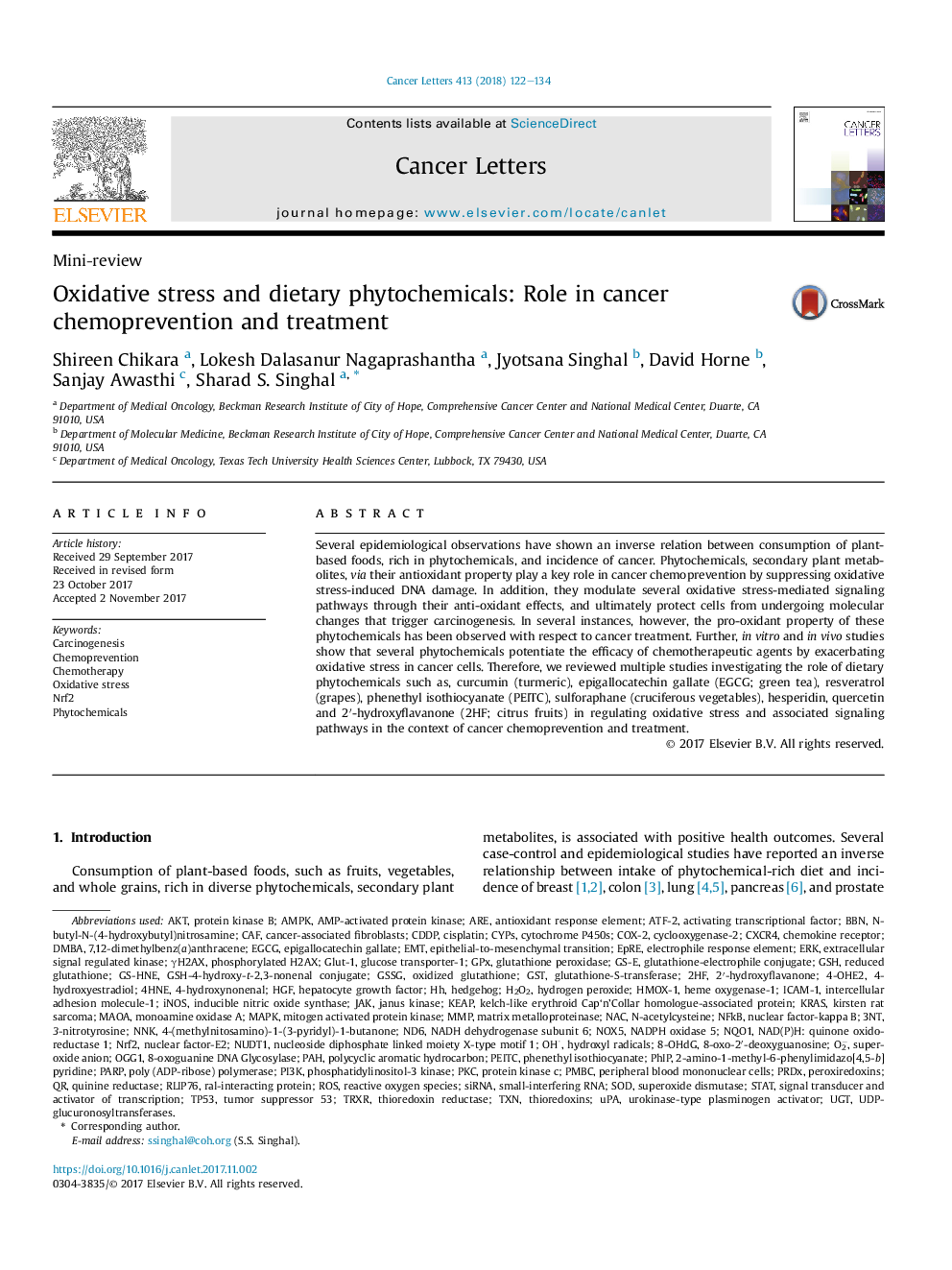| Article ID | Journal | Published Year | Pages | File Type |
|---|---|---|---|---|
| 8434981 | Cancer Letters | 2018 | 13 Pages |
Abstract
Several epidemiological observations have shown an inverse relation between consumption of plant-based foods, rich in phytochemicals, and incidence of cancer. Phytochemicals, secondary plant metabolites, via their antioxidant property play a key role in cancer chemoprevention by suppressing oxidative stress-induced DNA damage. In addition, they modulate several oxidative stress-mediated signaling pathways through their anti-oxidant effects, and ultimately protect cells from undergoing molecular changes that trigger carcinogenesis. In several instances, however, the pro-oxidant property of these phytochemicals has been observed with respect to cancer treatment. Further, in vitro and in vivo studies show that several phytochemicals potentiate the efficacy of chemotherapeutic agents by exacerbating oxidative stress in cancer cells. Therefore, we reviewed multiple studies investigating the role of dietary phytochemicals such as, curcumin (turmeric), epigallocatechin gallate (EGCG; green tea), resveratrol (grapes), phenethyl isothiocyanate (PEITC), sulforaphane (cruciferous vegetables), hesperidin, quercetin and 2â²-hydroxyflavanone (2HF; citrus fruits) in regulating oxidative stress and associated signaling pathways in the context of cancer chemoprevention and treatment.
Keywords
AMPKCAFPI3KMMP4-hydroxynonenalPAHKRASNrf2UGTGSHGSTNACEGCGGPXCOX-2ICAM-1ERKGSSGiNOSDMBA8-OHdGPhIPGLUT-1PKCCXCR4PARPactivating transcriptional factorHeme oxygenase-1TrxRHGFTP53uPANQO1CDDPγH2AXNFkBHMOX-1NAD(P)H: quinone oxidoreductase 14HNEMAOAOGG1ND6NADH dehydrogenase subunit 6thioredoxinsNNKPEITCN-butyl-N-(4-hydroxybutyl)nitrosamineRLIP76ATF-2TXNNOX5PMBC3NTGS-HNEPrdxOH·phosphorylated H2AX4-OHE2KeapJanus kinase2-amino-1-methyl-6-phenylimidazo[4,5-b]pyridine3-nitrotyrosine4-Hydroxyestradiol7,12-dimethylbenz(a)anthracene8-oxo-2′-deoxyguanosine8-oxoguanine DNA glycosylaseAMP-activated protein kinaseCYPsEpREMAPKN-acetylcysteineO2−small-interfering RNAROSsiRNAUDP-glucuronosyltransferasesHydrogen peroxideSTATsuperoxide anionAktepigallocatechin gallatethioredoxin reductaseOxidative stressEMTHedgehogHydroxyl radicalsSODCarcinogenesisperipheral blood mononuclear cellsinducible nitric oxide synthaseBBNSuperoxide dismutasecytochrome P450scisplatinCyclooxygenase-2extracellular signal regulated kinaseChemotherapyHepatocyte growth factorantioxidant response elementelectrophile response elementNuclear factor-kappa Bphosphatidylinositol-3 kinaseurokinase-type plasminogen activatorCancer-associated fibroblastsPhytochemicalsmatrix metalloproteinaseSignal transducer and activator of transcriptionintercellular adhesion molecule-1monoamine oxidase AAREH2O2Polycyclic aromatic hydrocarbonprotein kinase BProtein kinase Cmitogen activated protein kinasePeroxiredoxinspoly (ADP-ribose) polymerasePhenethyl isothiocyanateChemopreventionJAKreduced glutathioneKirsten Rat Sarcomaepithelial-to-mesenchymal transitionglutathione-S-transferaseoxidized glutathioneglutathione peroxidaseglucose transporter-1Reactive oxygen specieschemokine receptor
Related Topics
Life Sciences
Biochemistry, Genetics and Molecular Biology
Cancer Research
Authors
Shireen Chikara, Lokesh Dalasanur Nagaprashantha, Jyotsana Singhal, David Horne, Sanjay Awasthi, Sharad S. Singhal,
